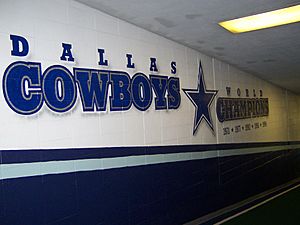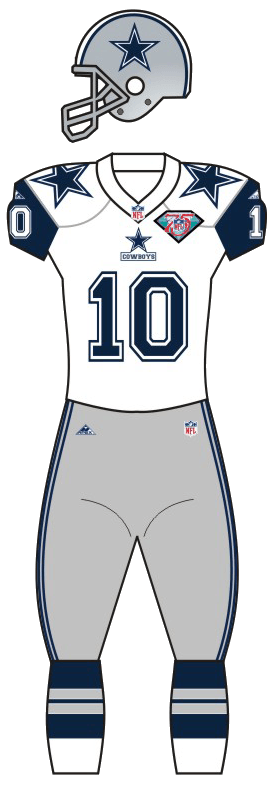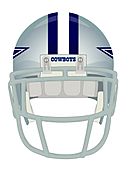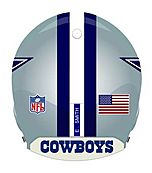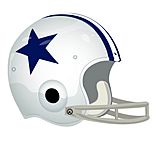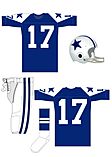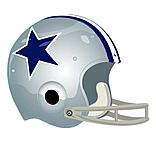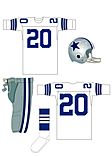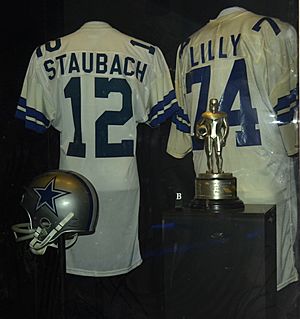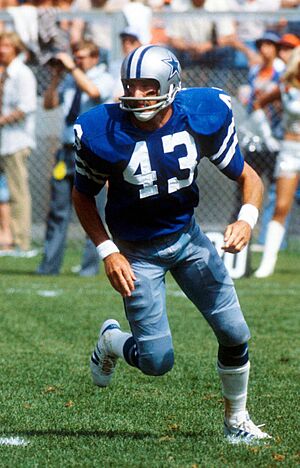Dallas Cowboys facts for kids
Quick facts for kids Dallas Cowboys |
|||||||||||||
|---|---|---|---|---|---|---|---|---|---|---|---|---|---|
|
|||||||||||||
| Basic info | |||||||||||||
| Established | January 28, 1960 | ||||||||||||
| Stadium | AT&T Stadium Arlington, Texas |
||||||||||||
| Headquartered | Ford Center at The Star Frisco, Texas |
||||||||||||
| Colors | Navy blue, metallic silver, royal blue, silver-green, white |
||||||||||||
| Fight song | Cowboys Stampede March | ||||||||||||
| Mascot | Rowdy | ||||||||||||
| Personnel | |||||||||||||
| Owner(s) | Jerry Jones | ||||||||||||
| CEO | Stephen Jones | ||||||||||||
| President | Jerry Jones | ||||||||||||
| General manager | Jerry Jones | ||||||||||||
| Head coach | Brian Schottenheimer | ||||||||||||
| Nicknames | |||||||||||||
|
|||||||||||||
| Team history | |||||||||||||
|
|||||||||||||
| Home fields | |||||||||||||
|
|||||||||||||
| League / conference affiliations | |||||||||||||
National Football League (1960–present)
|
|||||||||||||
| Championships | |||||||||||||
League championships: 5
|
|||||||||||||
Conference championships: 10
|
|||||||||||||
Division championships: 25
|
|||||||||||||
| Playoff appearances (36) | |||||||||||||
|
|||||||||||||
| Owner(s) | |||||||||||||
|
|||||||||||||
The Dallas Cowboys are a professional American football team located near Dallas, Texas. They play in the National Football League (NFL) as part of the National Football Conference (NFC) East division. The team's main office is in Frisco, Texas, and they have played their home games at AT&T Stadium in Arlington, Texas, since it opened in 2009.
The Cowboys joined the NFL as a new team in 1960. They are known for having many fans across the country, holding an NFL record for the most consecutive sold-out games. This streak of 190 sold-out games (home and away) began in 2002. The team has played in the Super Bowl eight times, which ties them for second-most appearances in history. They also have eight NFC championships, tying for the most in their conference. The Cowboys are the only NFL team to have 20 winning seasons in a row (from 1966 to 1985), missing the playoffs only twice during that time.
In 2015, the Dallas Cowboys became the first sports team to be valued at $4 billion, making them the most valuable sports team in the world, according to Forbes. They also earned $620 million in revenue in 2014, a record for a U.S. sports team. By 2018, they were the first NFL team valued at $5 billion, staying on Forbes' list as the most valuable NFL team for 12 years in a row.
Contents
- Team History
- How the Cowboys Started
- The Tom Landry Era (1960–1988)
- The Jerry Jones Era (1989–Present)
- Jimmy Johnson Years (1989–1993)
- Super Bowl XXVII Champions (1992)
- Super Bowl XXVIII Champions (1993)
- Barry Switzer Years (1994–1997)
- Super Bowl XXX Champions (1995)
- Gailey and Campo Years (1998–2002)
- Bill Parcells Years (2003–2006)
- Wade Phillips Years (2007–2010)
- Jason Garrett Years (2010–2019)
- Mike McCarthy Years (2020–2024)
- Brian Schottenheimer Years (2025–Present)
- Thanksgiving Day Games
- Logos and Uniforms
- Stadiums
- Training Camp Locations
- Nationwide Fanbase
- Rivalries
- Season-by-Season Records
- Notable Players
- Coaches and Staff
- Radio and Television
- Team Fight Song
- See also
Team History
How the Cowboys Started
Before the Dallas Cowboys were formed, there had not been an NFL team in the southern United States since the Dallas Texans left in 1952. Two businessmen tried to bring a team to Dallas. One, Lamar Hunt, ended up starting a new league called the American Football League. The other, Clint Murchison Jr., kept trying to get an NFL team.
Murchison tried to buy the Washington Redskins in 1958 to move them to Dallas. An agreement was almost made, but the Redskins owner, George Preston Marshall, changed the terms at the last minute. This made Murchison angry, and he stopped the deal. Marshall then tried to block Murchison from getting any NFL team in Dallas. At that time, all team owners had to agree for a new team to join the league.
Marshall had a disagreement with the Redskins band leader, Barnee Breeskin, who wrote the music for the team's fight song, "Hail to the Redskins". Breeskin owned the rights to the song. Knowing Murchison's problem, Breeskin offered to sell the song rights to Murchison before the 1959 expansion vote. Murchison bought the song for $2,500.
Before the vote, Murchison told Marshall that he now owned the song and could stop Marshall from playing it during games. After a heated discussion, Murchison sold the rights back to Marshall. In return, Marshall agreed to vote for Murchison to get a team. This moment helped start the Cowboys–Redskins rivalry. Murchison then hired Tex Schramm as president and general manager, Gil Brandt to find players, and Tom Landry as head coach. These three leaders guided the Cowboys for 30 years.
The Tom Landry Era (1960–1988)

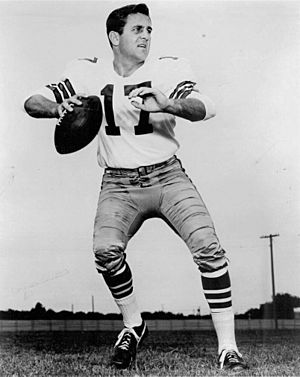
Like most new teams, the Cowboys struggled at first. They did not win a game in their first season. However, Coach Landry slowly improved the team. By 1965, they had an even record. A year later, they won two Eastern Conference titles in 1966 and 1967. But they lost the NFL Championship Game both times to the Green Bay Packers, including the famous "Ice Bowl" in 1967. They won division titles in 1968 and 1969 but lost in the playoffs to the Cleveland Browns.
From 1970 to 1979, the Cowboys won 105 regular season games, more than any other NFL team during that time. They also played in five Super Bowls, winning two of them in 1971 and 1977.
In 1970, led by quarterback Craig Morton, the Cowboys finished 10–4. They won their first-ever NFC Championship Game to reach Super Bowl V. They lost a close game 16–13 to the Baltimore Colts. Despite the loss, linebacker Chuck Howley was named the Super Bowl MVP, the only time a player from the losing team has won this award.
Super Bowl VI Champions (1971)
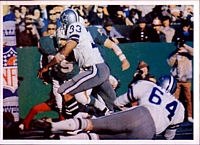
The Cowboys moved from the Cotton Bowl to Texas Stadium in 1971. Coach Landry made Roger Staubach the main quarterback. Dallas won their last seven regular season games, finishing 11–3. They then beat the Minnesota Vikings and San Francisco 49ers in the playoffs. In Super Bowl VI, Staubach was named MVP, and the Cowboys rushed for a record 252 yards. They defeated the Miami Dolphins 24–3, finally winning a Super Bowl.
After missing the playoffs in 1974, the team drafted well in 1975, adding future Hall of Famer Randy White. This new talent helped the Cowboys reach the playoffs in 1975 as a wild card team. They lost to the Pittsburgh Steelers 21–17 in Super Bowl X.
Super Bowl XII Champions (1977)
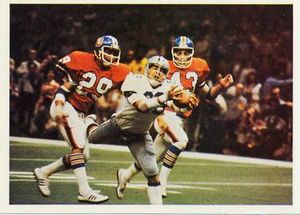
Dallas started the 1977 season with an 8–0 record and finished 12–2. In the postseason, they easily beat the Chicago Bears and Minnesota Vikings. They then defeated the Denver Broncos 27–10 in Super Bowl XII. Defensive linemen Randy White and Harvey Martin were named co-Super Bowl MVPs, the only time two players have shared the award. After the 1978 season, Dallas returned to the Super Bowl but lost to Pittsburgh 35–31. An NFL Films editor called the Cowboys "America's Team" after this loss, a nickname that has stayed with them.
Danny White became the Cowboys' starting quarterback in 1980 after Roger Staubach retired. In 1980, the Cowboys went 12–4 and made the playoffs as a Wild Card team. They reached the NFC Championship but lost to the Philadelphia Eagles 20–7.
In 1981, Dallas won another division championship. They advanced to the NFC Championship Game against the San Francisco 49ers. Despite leading late in the game, they lost 28–27 on a famous play known as "The Catch".
The 1982 season was shorter due to a player strike. Dallas made the playoffs for the eighth year in a row. They reached their third straight Conference Championship game but lost to the Washington Redskins 31–17.
The 1983 season saw the Cowboys go 12–4 and make the playoffs again, but they were upset at home by the Rams. Before the 1984 season, owner Clint Murchison Jr. sold the team to H.R. "Bum" Bright. Dallas finished 9–7 that season, missing the playoffs for the first time in 10 years. After winning a division title in 1985, they lost to the Rams in the Divisional round.
The team struggled from 1986 to 1988, with records of 7–9, 7–8, and 3–13. Due to financial difficulties, Bright was forced to sell the team to Jerry Jones on February 25, 1989, for $150 million.
The Jerry Jones Era (1989–Present)
Jimmy Johnson Years (1989–1993)
Jerry Jones immediately fired Tom Landry and hired University of Miami coach Jimmy Johnson. Johnson had been Jones' teammate in college. The Cowboys also drafted quarterback Troy Aikman with the first pick. Later that year, they traded running back Herschel Walker for many players and draft picks. This trade helped Dallas rebuild the team, even though they finished the 1989 season with a 1–15 record, their worst in almost 30 years.
Johnson quickly brought the Cowboys back to being one of the NFL's best teams. Smart drafting added players like Emmitt Smith in 1990 and Darren Woodson in 1992. These young talents joined experienced players like Michael Irvin and Charles Haley.
In 1990, Dallas won their first home game since 1988. They finished the season with a 7–9 record.
By 1991, the Cowboys improved to 11–5. They won their first playoff game since 1982 against the Bears. Their season ended with a loss to the Lions.
Super Bowl XXVII Champions (1992)
In 1992, Dallas set a team record with 13 regular-season wins. They entered the playoffs as the second seed and beat the Philadelphia Eagles 34–10. They then defeated the San Francisco 49ers 30–20 to reach their first Super Bowl since 1978. Dallas crushed the Buffalo Bills 52–17 in Super Bowl XXVII, forcing a record nine turnovers. Johnson became the first coach to win both a college national championship and a Super Bowl.
Super Bowl XXVIII Champions (1993)
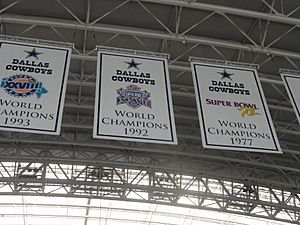
Despite starting the 1993 season 0–2, Dallas finished 12–4 as the top seed in the NFC. They sent a record 11 players to the Pro Bowl. They beat the Green Bay Packers 27–17 and then the 49ers 38–21 in the NFC Championship. The Cowboys again defeated the Buffalo Bills in Super Bowl XXVIII, 30–13. They became the first team to win a Super Bowl after starting 0–2.
Barry Switzer Years (1994–1997)
After Super Bowl XXVIII, Jimmy Johnson resigned due to disagreements with Jerry Jones. Jones hired former University of Oklahoma coach Barry Switzer. The Cowboys finished 12–4 in 1994 and reached the NFC Championship, but lost to the San Francisco 49ers 38–28.
Super Bowl XXX Champions (1995)
Before the 1995 season, Jerry Jones signed All-Pro cornerback Deion Sanders. Dallas started 4–0. Emmitt Smith set an NFL record with 25 rushing touchdowns that season. They finished 12–4 as the top seed. They beat the Eagles 30–11 and Green Bay 38–27 in the playoffs. In Super Bowl XXX, the Cowboys defeated the Pittsburgh Steelers 27–17 for their fifth Super Bowl championship. Switzer joined Johnson as the only coaches to win both a college national championship and a Super Bowl.

The Cowboys' success began to fade due to player changes, age, and injuries. They finished 1996 with a 10–6 record and won the NFC East. They beat Minnesota in the Wild Card round but lost to the Carolina Panthers in the Divisional Round.
In 1997, the Cowboys went 6–10, losing their last six games. Switzer resigned in January 1998, and Chan Gailey became the new head coach.
Gailey and Campo Years (1998–2002)
Gailey led the team to two playoff appearances. They won the NFC East in 1998 with a 10–6 record but were upset at home by the Arizona Cardinals.
In 1999, Dallas went 8–8. The season ended with a playoff loss to the Minnesota Vikings. Gailey was fired, becoming the first Cowboys coach not to reach a Super Bowl.
Defensive coordinator Dave Campo was promoted to head coach for the 2000 season. Quarterback Troy Aikman suffered a serious concussion that ended his career. The Cowboys finished 5–11. A highlight was Emmitt Smith having his 10th straight 1,000-yard rushing season.
2001 was another tough year. Aikman was released and retired. The Cowboys finished 5–11 again.
In 2002, Emmitt Smith broke the all-time NFL rushing record. However, the team lost its last four games to finish 5–11. This was Smith's last game as a Cowboy. Campo was fired after the season.
Bill Parcells Years (2003–2006)
Jerry Jones convinced Bill Parcells to come out of retirement to coach the Cowboys. The team surprised many in 2003 with a 7–2 start. They finished 10–6 and made the playoffs as a wild card, but lost to the Carolina Panthers 29–10.
In 2004, Dallas finished 6–10. In 2005, they started 7–3 but ended 9–7.
2006 was notable for the signing of wide receiver Terrell Owens. During a game against the New York Giants, starting quarterback Drew Bledsoe was replaced by backup Tony Romo. Romo became the starter and led the team to a 9–7 record and a playoff spot. They lost to the Seattle Seahawks 21–20. After the season, Parcells retired and Wade Phillips became head coach.
Wade Phillips Years (2007–2010)
Dallas started the 2007 season by winning their first five games. They won 12 of their first 13 games, earning the top seed in the NFC playoffs. However, they lost in the divisional round 21–17 to the eventual Super Bowl champion New York Giants.
The 2008 season started strong but was affected by injuries to key players like Tony Romo. The team struggled in December and missed the playoffs after losing to the Philadelphia Eagles in the final game.
On May 2, 2009, the Cowboys' practice facility collapsed during a wind storm, injuring several players and coaches.
The 2009 season saw Dallas overcome a slow start. They had a three-game winning streak, including wins over the Atlanta Falcons and Philadelphia Eagles. Despite some late-season losses, they finished strong, beating the undefeated New Orleans Saints. They also had back-to-back shutouts against the Washington Redskins and Eagles, winning the NFC East title. In the playoffs, they beat the Eagles for their first playoff win since 1996. However, their run ended with a 34–3 loss to the Minnesota Vikings.
After starting the 2010 season with a 1–7 record, Phillips was fired and offensive coordinator Jason Garrett became the interim head coach.
Jason Garrett Years (2010–2019)
With Garrett as interim coach, the Cowboys improved to finish the 2010 season 6–10. Garrett was then named the permanent head coach.
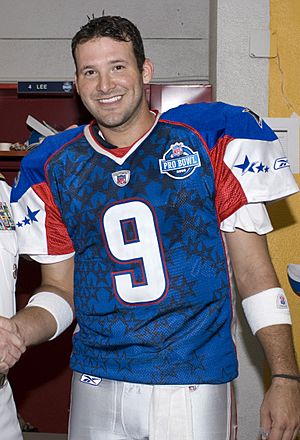
In the 2011 season, the Cowboys lost a close opener to the New York Jets. In Week 2, Tony Romo was injured but returned to lead a comeback win against the San Francisco 49ers. Dallas finished 8–8, losing a Week 17 game to the New York Giants that decided the NFC East title. The Giants went on to win Super Bowl XLVI.
The Cowboys started the 2012 season with a win over the defending Super Bowl champion New York Giants. They stayed around a .500 record for most of the season. For the second year in a row, they faced a Week 17 game to win the division, but lost to the Washington Redskins 28–18, finishing 8–8 again.
In the 2013 season, Dallas again started with a win over the New York Giants. They battled the Philadelphia Eagles for the division title. Quarterback Tony Romo suffered a back injury late in the season. Backup Kyle Orton led them into a Week 17 showdown against the Eagles for the NFC East crown, but they lost 24–22, finishing 8–8 for the third straight year.
The 2014 season began with a loss but was followed by a six-game winning streak, including a win over the Super Bowl champion Seattle Seahawks. Romo injured his back again but returned to lead the team. Dallas won the NFC East title by beating the Indianapolis Colts and finished the regular season 12–4.
In the 2014 playoffs, the Cowboys hosted the Detroit Lions. Dallas came back from a 14-point halftime deficit to win 24–20. This was their first playoff win after being down by 10 or more points at halftime. The next week, they lost to the Green Bay Packers 26–21 in a close game that ended their season.
In 2015, running back DeMarco Murray left for the Eagles. Wide receiver Dez Bryant signed a new contract. The Cowboys started 2–0 but then went on a seven-game losing streak due to injuries to Romo and Bryant. They finished the season 4–12.
In 2016, rookie quarterback Dak Prescott became the starter after Tony Romo was injured in the preseason. Dallas lost Week 1 but then went on an eleven-game winning streak. Romo announced that Prescott had earned the starting job.

Dallas finished 13–3, tying their best regular-season record. They lost to the Green Bay Packers in the divisional round of the playoffs on a last-second field goal. Dak Prescott was named NFL Rookie of the Year, and Ezekiel Elliott led the league in rushing yards. Jason Garrett was named Coach of the Year.
2017 was the first season without quarterback Tony Romo, who retired. The Cowboys finished 9–7 and missed the playoffs. After the season, Dez Bryant was released, and tight end Jason Witten retired.
In 2018, the Cowboys finished 10–6 and won the NFC East. They beat the Seattle Seahawks in the Wild Card Round but lost to the Los Angeles Rams in the Divisional Round.
Mike McCarthy Years (2020–2024)
After the 2019 season, the Cowboys parted ways with head coach Jason Garrett. Mike McCarthy, who led the Green Bay Packers to a Super Bowl win, was hired.
McCarthy's first win with the Cowboys came in Week 2 against the Atlanta Falcons. On October 11, 2020, quarterback Dak Prescott suffered a serious ankle injury that ended his season. Despite this, the Cowboys remained in playoff contention for much of the year, finishing 6–10. The team's defense struggled significantly.
The Cowboys' 2021 season was a winning one, their first since 2018. They clinched a playoff spot and then the NFC East title, their first division title since 2018. They swept all their NFC East opponents for the first time since 1998. Rookie Micah Parsons was named Defensive Rookie of the Year. The Cowboys had the league's highest-scoring offense. They finished 12–5, their best record since 2016. However, they lost to the San Francisco 49ers 23–17 in the wild card round of the playoffs.
The 2022 season also saw a 12–5 record. They clinched a playoff spot, marking the first time since 2006–2007 that they made the postseason in back-to-back seasons. Quarterback Dak Prescott received the Walter Payton NFL Man of the Year Award for his community work. In the wild-card round, the Cowboys defeated the Tampa Bay Buccaneers, winning their first road playoff game since 1992. However, they were defeated by the San Francisco 49ers in the divisional round for the second year in a row.
In 2023, the Cowboys achieved a 12–5 record for the third year in a row. They won the NFC East division title. They finished tied for the best record in the NFC but earned the second seed in the playoffs. This was their first time making the playoffs three years in a row since 1991–1996. However, the Cowboys lost in the Wild Card round to the Green Bay Packers 48–32. On January 13, 2025, it was announced that Mike McCarthy would not return as head coach.
Brian Schottenheimer Years (2025–Present)
On January 24, 2025, Brian Schottenheimer was promoted from offensive coordinator to head coach.
Thanksgiving Day Games
In 1966, the Cowboys agreed to host a second NFL Thanksgiving game. The Detroit Lions had already made hosting a Thanksgiving game a tradition. General manager Tex Schramm wanted to get more attention for his team, which had struggled. The NFL even guaranteed some money to the Cowboys, thinking the game might not be popular. Over 80,000 fans watched the Cowboys beat the Cleveland Browns 26–14 at the Cotton Bowl.
In 1975 and 1977, the St. Louis Cardinals temporarily replaced Dallas as a host team. The games were not as successful. Because of this, Dallas resumed hosting Thanksgiving games regularly in 1978. The Cowboys then requested and received an agreement that guaranteed them a spot on Thanksgiving Day forever.
Logos and Uniforms
Team Logo
The Dallas Cowboys' blue star logo is one of the most famous team logos in sports. It represents Texas as "The Lone Star State." The blue star was solid until 1964, when a white line and blue border were added. The logo has stayed the same since then.
Uniform Styles
The Cowboys' white home jersey has royal blue numbers and two stripes on the sleeves outlined in black. The home pants are a metallic silver-green color. The navy blue road jerseys have white lettering and numbers with navy pinstripes. They have a white/gray/white stripe on each sleeve and a Cowboys star logo on the stripes. The away pants are a pearlish metallic-silver color.
The team's helmets are a unique silver-blue color. They have a blue/white/blue stripe down the middle. The Cowboys also add a small blue strip of tape with the player's name on the back of the helmet.
Home and Away Uniform History
When the Dallas Cowboys started in 1960, their uniform included a white helmet with a blue star. They wore blue jerseys with white sleeves at home and the opposite for away games.
In 1964, the Cowboys changed to a simpler look, similar to their current uniform. The helmet became silver-blue with a blue-white-blue stripe. The blue star logo was kept but with a white border. In 1964, the NFL allowed teams to wear white jerseys at home. The Cowboys have worn white at home ever since, except for special "throwback" games.
In 1966, the jerseys were changed slightly. In 1967, the helmet star logo was made bigger with a blue outline. This logo and uniform style have changed very little since then.
Some small changes happened over the years:
- From 1970 to 1973, numbers on the shoulders moved to the sleeves.
- From 1982 to 1988, pants had a white number near the hip.
- In 1980, the blue jersey became a slightly darker shade.
- Since 1982, player names on jerseys have been in a "serif" style.
- Since 1996, the blue jersey has white/gray/white stripes and the "Cowboys" name on the neckline.
During the 1976 season, the helmet stripe was temporarily red-white-blue to celebrate the United States' bicentennial. This stripe returned in 2021 for one game each year to honor Medal of Honor recipients.
In 1994, for the NFL's 75th Anniversary, the Cowboys introduced a white "Double-Star" jersey. They also wore their 1960–63 road jersey with a silver helmet for one game.
In 1995, the team wore a navy "Double-Star" jersey for some away games. This jersey was later used for "Classic Throwback Weekend" games.
In 2004, the Cowboys brought back their original 1960–1963 uniform for Thanksgiving Day. This became their alternate jersey, usually worn once a year.
In 2013, the NFL made a rule that players could not use alternate helmets. This meant the Cowboys' white 1960s throwback helmets could not be used. However, this rule changed in 2022, and the Cowboys brought back the white 1960s helmet.
In 2015, the Cowboys released their Color Rush uniform, which was a version of the 1990s "Double Star" alternates. It was first used on Thanksgiving Day. In 2022, the "Color Rush" uniforms were worn with a white helmet.
In 1964, Tex Schramm started the tradition of the Cowboys wearing their white jersey at home. He wanted fans to see different opponent colors. Another reason was the intense Texas heat during early season games at Texas Stadium.
Over the years, the Cowboys' blue jersey has been seen as "jinxed" because the team often lost when wearing them. This idea gained attention after they lost Super Bowl V in blue jerseys.
Since the white home uniform tradition began in 1964, Dallas only wore blue uniforms in one regular season game in 1968, 1975, 1976, 1977, 1998, 2010, and 2020. In 2019, they wore their blue uniforms eight times, the most in any season.
Opposing teams sometimes wear their white jerseys at home to try to "jinx" the Cowboys.

Thanksgiving Day Uniforms
For Thanksgiving Day games, the Cowboys have worn special uniforms. On November 24, 1994, they debuted their white "Double-Star" jersey. This game is famous for then-backup quarterback Jason Garrett leading a comeback win.
In 2004, the team wore blue jerseys similar to those from their first four years, with white helmets and pants. This "throwback" uniform was used until 2012.
In 2013, the NFL's "One-helmet" rule prevented the Cowboys from using their white throwback helmets. So, they wore their regular blue jerseys for Thanksgiving games.
In 2015, the Cowboys wore a "Color Rush" uniform on Thanksgiving Day. This uniform was used again on Thanksgiving in 2020. In other seasons, they wore their standard white or blue uniforms.
In 2022, the NFL allowed alternate helmets again. The Cowboys brought back the white helmet and navy "throwback" uniforms on November 24, 2022, against the New York Giants.
Stadiums
Cotton Bowl
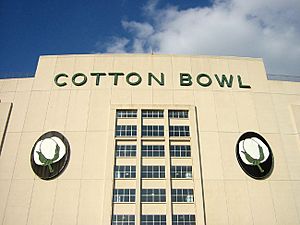
The Cotton Bowl is a stadium that opened in 1932. It was known for the large crowds drawn by college football player Doak Walker in the 1940s. The Dallas Cowboys played their home games at the Cotton Bowl for 11 years, from 1960 to 1971. It is the only Cowboys stadium located within the Dallas city limits.
Texas Stadium
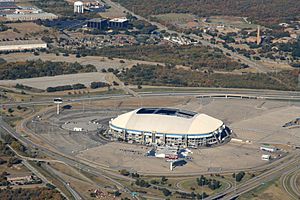
For most of their history, the Cowboys played at Texas Stadium in Irving, just outside Dallas. The stadium opened in 1971 and was famous for its hole in the roof. The Cowboys played their final game at Texas Stadium on December 20, 2008. After AT&T Stadium opened in 2009, Texas Stadium was demolished on April 11, 2010.
AT&T Stadium
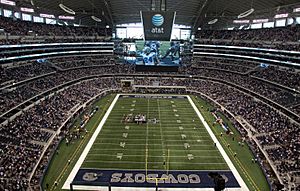
AT&T Stadium, formerly Cowboys Stadium, is a domed stadium with a retractable roof in Arlington. Jerry Jones and the city of Arlington funded the stadium, which cost $1.3 billion. It opened on May 29, 2009, and can seat up to 100,000 fans. It is one of the largest domed stadiums in the world.
A special feature of AT&T Stadium is its huge, center-hung high-definition television screen. At one point, it was the largest in the world. The screen is 160 feet by 72 feet.
At the stadium's first preseason game, a punt hit the screen. The screen is high enough to meet NFL rules. The first regular season game in 2009 was against the New York Giants, with a record 105,121 fans attending. The Cowboys lost that game.
The Cowboys got their first regular-season home win on September 28, 2009, beating the Carolina Panthers 21–7. On July 25, 2013, AT&T bought the rights to the stadium's name.
Training Camp Locations
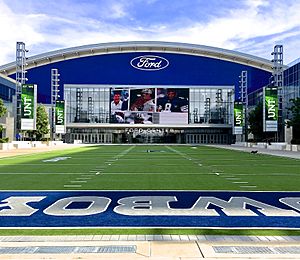
The Dallas Cowboys have held their training camps in various locations:
- 1960: Pacific University, Forest Grove, Oregon
- 1961: St. Olaf College, Northfield, Minnesota
- 1962: Northern Michigan College, Marquette, Michigan
- 1963–1989: California Lutheran College, Thousand Oaks, California
- 1990–1997: St. Edward's University, Austin, Texas
- 1998–2002: Midwestern State University, Wichita Falls, Texas
- 2001, 2004–2006, 2008, 2012–2015: River Ridge Sports Complex, Oxnard, California
- 2002–2003, 2007, 2009: The Alamodome, San Antonio, Texas
- 2010–2011: The Alamodome, San Antonio, Texas and River Ridge Sports Complex, Oxnard, California
- 2016–present: The Ford Center at The Star, Frisco, Texas
Nationwide Fanbase
Fan Support
Since joining the NFL in 1960, the Cowboys have had strong fan support in Texas and across the country. Because of their many fans at both home and away games, the Cowboys are often called "America's Team".
Criticism
Despite their success and large fanbase, many fans of other NFL teams dislike the Cowboys. Some have even called the Cowboys' fanbase the most annoying in sports.
Rivalries
The NFC East division includes the Cowboys, Philadelphia Eagles, Washington Commanders, and New York Giants. This division has stayed mostly the same since the NFL and AFL merged. Because of this, the Cowboys have some of the oldest and most intense rivalries in football.
Divisional Rivals
Philadelphia Eagles
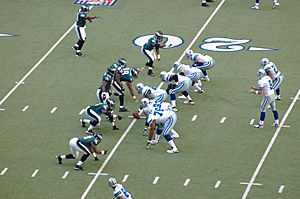
The rivalry between the Cowboys and the Philadelphia Eagles has been very strong since the late 1970s. In January 1981, the Eagles beat the Cowboys 20–7 in the NFC Championship. The rivalry became more intense in the 1980s and 1990s due to actions by Eagles fans and coach Buddy Ryan. This included the 1989 "Bounty Bowl" games, where fans threw snowballs at the Cowboys.
In 2008, the Eagles defeated the Cowboys 44–6 in a game where both teams could have made the playoffs. The next season, the Cowboys got revenge by beating the Eagles three times, including a 24–0 shutout. This was Dallas's first three-game sweep against any opponent.
In 2013, the Cowboys won the first game against the Eagles. In Week 17, they played again for the NFC East title. The Cowboys lost a close game after Tony Romo was injured. In 2014, both teams won on the road against each other. Dallas's win in Philadelphia helped them make the playoffs and kept the Eagles out. Dallas leads the all-time series 73–56.
New York Giants
The first game between the New York Giants and Cowboys was a 31–31 tie in 1960. Dallas got its first win in 1961. A notable moment was the Giants beating Dallas in the 2007 playoffs on their way to winning Super Bowl XLII. Dallas currently leads the all-time series 75–47–2.
Washington Commanders
The Washington Commanders and Dallas Cowboys have one of the greatest NFL rivalries. Some say it started even before the Cowboys were formed, due to a disagreement between Washington's owner and Cowboys founder Clint Murchison, Jr.. Their rivalry began in 1960, with Washington winning the first game 26–14. They have played 126 regular-season games and two NFC Championships. Dallas leads the regular season series 78–46–2, but Washington leads the playoff series 2–0. Notable moments include Washington's win over Dallas in the 1982 NFC Championship.
Conference Rivals
San Francisco 49ers
The rivalry between the Dallas Cowboys and San Francisco 49ers has been strong since the 1970s. They have played seven playoff games. The Cowboys beat the 49ers in the 1970, 1971, and 1972 playoffs. The 1981 NFC Championship Game, where the 49ers won on Joe Montana's famous pass ("The Catch"), is one of the most famous games in NFL history. The rivalry became even more intense from 1992–1994, when they met in the NFC Championship three times. The winner of these games went on to win the Super Bowl. Both teams have five Super Bowl wins. The 49ers lead the all-time series 20–19–1.
Green Bay Packers
The rivalry between the Dallas Cowboys and the Green Bay Packers is well-known. These teams do not play every year, usually meeting once every three years. The rivalry has led to many memorable playoff games.
The Packers lead the regular season series 20–17 and the postseason series 5–4.
Los Angeles Rams
The Cowboys also had a strong rivalry with the Los Angeles Rams, especially in the 1970s and 1980s. They played eight playoff games during this time. Dallas and the Rams are tied in the all-time regular season series 18–18, but the Rams lead the playoff series 5–4.
Minnesota Vikings
The Cowboys lead the all-time series against the Minnesota Vikings 19–15. They have met seven times in the postseason. This rivalry includes famous moments like the 1975 "Hail Mary" pass and the Herschel Walker trade.
Interconference Rivals
Houston Texans
The Cowboys have a rivalry with the Houston Texans for bragging rights in Texas. This tradition started with the Houston Oilers before they moved. The Texans beat the Cowboys in their first season in 2002. The Cowboys lead the all-time series 4–2.
Pittsburgh Steelers
The Cowboys and Pittsburgh Steelers first played in 1960. They later met in three Super Bowls, all very close games. The Steelers won Super Bowl X and Super Bowl XIII, while the Cowboys won Super Bowl XXX. The rivalry was strong in the 1970s due to the teams' different styles: the Cowboys were known for their passing game and "Doomsday Defense," while the Steelers had a strong running game and "Steel Curtain" defense. Both teams have many fans across the country. Dallas leads the all-time series 17–16, including playoffs.
Season-by-Season Records
Notable Players
Current Roster
|
Dallas Cowboys roster
|
|||||||||
|---|---|---|---|---|---|---|---|---|---|
Quarterbacks
Running backs
Wide receivers
Tight ends
|
Offensive linemen
Defensive linemen
|
Linebackers
Defensive backs
Special teams
|
Reserve lists
→ AFC rosters → NFC rosters |
||||||
Pro Football Hall of Famers

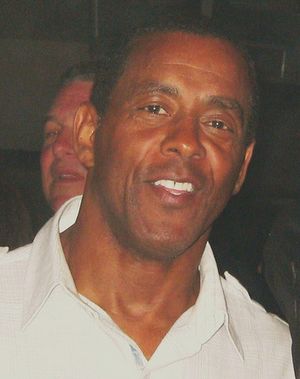

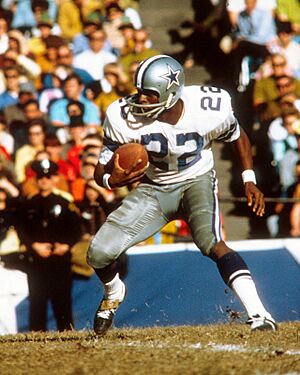
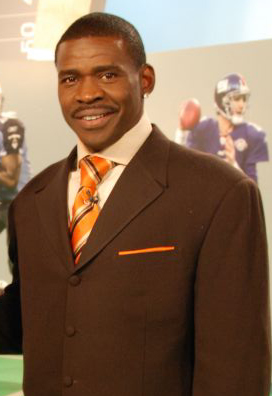
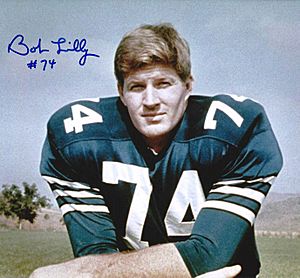
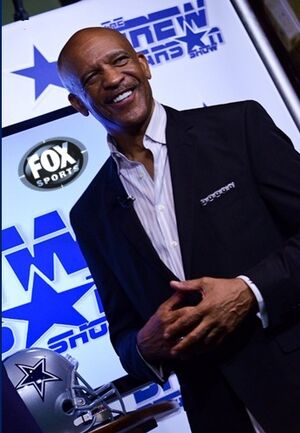

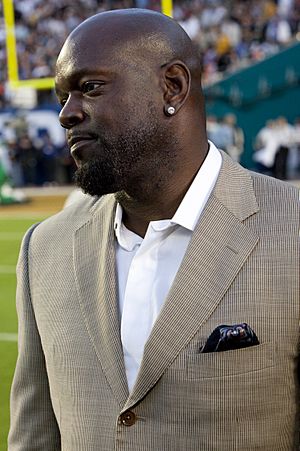

| Dallas Cowboys Hall of Famers | ||||
|---|---|---|---|---|
| Players | ||||
| No. | Name | Position | Seasons | Inducted |
| 79 | Forrest Gregg | OT | 1971 | 1977 |
| 19 | Lance Alworth | WR | 1971–1972 | 1978 |
| 74 | Bob Lilly | DT | 1961–1974 | 1980 |
| 26 | Herb Adderley | CB | 1970–1972 | 1981 |
| 12 | Roger Staubach | QB | 1969–1979 | 1985 |
| 89 | Mike Ditka | TE | 1969–1972 | 1988 |
| 33 | Tony Dorsett | RB | 1977–1987 | 1994 |
| 81 | Jackie Smith | TE | 1978 | 1994 |
| 54 | Randy White | DT, LB | 1975–1988 | 1994 |
| 20 | Mel Renfro | CB | 1964–1977 | 1996 |
| 25 | Tommy McDonald | WR | 1964 | 1998 |
| 8 | Troy Aikman | QB | 1989–2000 | 2006 |
| 70 | Rayfield Wright | OT | 1967–1979 | 2006 |
| 88 | Michael Irvin | WR | 1988–1999 | 2007 |
| 22 | Bob Hayes | WR | 1965–1974 | 2009 |
| 22 | Emmitt Smith | RB | 1990–2002 | 2010 |
| 21 | Deion Sanders | CB, KR | 1995–1999 | 2011 |
| 73 | Larry Allen | G | 1994–2005 | 2013 |
| 94 | Charles Haley | DE | 1992–1996 | 2015 |
| 81 | Terrell Owens | WR | 2006–2008 | 2018 |
| 17 | Harold Carmichael | WR | 1984 | 2020 |
| 43 | Cliff Harris | S | 1970–1979 | 2020 |
| 88 | Drew Pearson | WR | 1973–1983 | 2021 |
| 54 | Chuck Howley | LB | 1961–1973 | 2023 |
| 55 | Zach Thomas | LB | 2008 | 2023 |
| 94 | DeMarcus Ware | LB | 2005–2013 | 2023 |
| Coaches and Contributors | ||||
| Name | Position | Seasons | Inducted | |
| Tom Landry | Coach | 1960–1988 | 1990 | |
| Tex Schramm | President/GM | 1960–1988 | 1991 | |
| Bill Parcells | Coach | 2003–2006 | 2013 | |
| Jerry Jones | Owner/Executive | 1989–present | 2017 | |
| Gil Brandt | Executive | 1960–1988 | 2019 | |
| Jimmy Johnson | Coach | 1989–1993 | 2020 | |
Super Bowl MVPs
Seven Cowboys players have won the Super Bowl MVP award.
| Super Bowl MVP Winners | ||
|---|---|---|
| Super Bowl | Player | Position |
| V | Chuck Howley | LB |
| VI | Roger Staubach | QB |
| XII | Randy White | DT |
| Harvey Martin | DE | |
| XXVII | Troy Aikman | QB |
| XXVIII | Emmitt Smith | RB |
| XXX | Larry Brown | CB |
Ring of Honor
The Cowboys do not officially retire jersey numbers. Instead, they have a "Ring of Honor" displayed around the field. It was first at Texas Stadium and is now at AT&T Stadium. The first person inducted was Bob Lilly in 1975. By 2005, it had 17 names, mostly former players, plus one head coach and one general manager.
The Ring of Honor has caused some discussion over the years. When Jerry Jones bought the team, he inducted Lee Roy Jordan. Jones also worked to convince Tom Landry to accept induction, which he did in 1993. In 2003, Jones inducted Tex Schramm.
Troy Aikman, Emmitt Smith, and Michael Irvin, known as "The Triplets," were inducted into the Ring of Honor on September 19, 2005.
Charles Haley, Larry Allen, and Drew Pearson were inducted on November 6, 2011.
Darren Woodson was inducted on November 1, 2015. Executive Gil Brandt was inducted on November 29, 2018.
The most recent inductees were DeMarcus Ware on October 29, 2023, and Jimmy Johnson on December 30, 2023.
| Pro Football Hall of Fame finalist | |
| Inducted or Enshrined in the Pro Football Hall of Fame |
| No. | Name | Position | Years With Club | Inducted |
| 74 | Bob Lilly | DT | 1961–1974 | November 23, 1975 |
| 17 | Don Meredith | QB | 1960–1968 | November 7, 1976 |
| 43 | Don Perkins | FB | 1961–1968 | November 7, 1976 |
| 54 | Chuck Howley | LB | 1961–1973 | October 30, 1977 |
| 20 | Mel Renfro | CB | 1964–1977 | October 25, 1981 |
| 12 | Roger Staubach | QB | 1969–1979 | October 9, 1983 |
| 55 | Lee Roy Jordan | LB, C | 1963–1976 | October 29, 1989 |
| — | Tom Landry | Head Coach | 1960–1988 | November 7, 1993 |
| 33 | Tony Dorsett | RB | 1977–1987 | October 9, 1994 |
| 54 | Randy White | DT, LB, DE | 1975–1988 | October 9, 1994 |
| 22 | Bob Hayes | WR | 1965–1974 | September 23, 2001 |
| — | Tex Schramm | General Manager | 1960–1989 | October 12, 2003 |
| 43 | Cliff Harris | S | 1970–1979 | October 10, 2004 |
| 70 | Rayfield Wright | OT | 1967–1979 | October 10, 2004 |
| 8 | Troy Aikman | QB | 1989–2000 | September 19, 2005 |
| 88 | Michael Irvin | WR | 1988–1999 | September 19, 2005 |
| 22 | Emmitt Smith | RB | 1990–2002 | September 19, 2005 |
| 88 | Drew Pearson | WR | 1973–1983 | November 6, 2011 |
| 94 | Charles Haley | DE | 1992–1996 | November 6, 2011 |
| 73 | Larry Allen | OG, OT | 1994–2005 | November 6, 2011 |
| 28 | Darren Woodson | S | 1992–2004 | November 1, 2015 |
| — | Gil Brandt | VP Player Personnel | 1960–1988 | November 29, 2018 |
| 94 | DeMarcus Ware | LB | 2005–2013 | October 29, 2023 |
| — | Jimmy Johnson | Head Coach | 1989–1993 | December 30, 2023 |
Unofficially Retired Numbers
The Dallas Cowboys do not officially retire jersey numbers. However, some numbers are kept out of use. As of 2022, six numbers are unofficially inactive: Troy Aikman's No. 8, Roger Staubach's No. 12, Bob Hayes' and Emmitt Smith's No. 22, Bob Lilly's No. 74, and Jason Witten's No. 82.
Career Leaders
- Passing yards: 34,183 Tony Romo (2004–2016)
- Pass completions: 2,898 Troy Aikman (1989–2000)
- Passing touchdowns: 248 Tony Romo (2004–2016)
- Rushing yards: 17,162 Emmitt Smith (1990–2002)
- Rushing touchdowns: 153 Emmitt Smith (1990–2002)
- Receptions: 1,215 Jason Witten (2003–2017, 2019)
- Receiving yards: 12,977 Jason Witten (2003–2017, 2019)
- Receiving touchdowns: 73 Dez Bryant (2010–2017)
- Points scored: 986 Emmitt Smith (1990–2002)
- Field goals made: 186 Dan Bailey (2011–2017)
- Total punt yardage: 24,542 Mike Saxon (1985–1992)
- Punting average: 45.3 Mat McBriar (2003–2011)
- Kickoff return yards: 3,416 Kevin Williams (1993–1996)
- Punt Return yards: 1,803 Kelvin Martin (1987–1992, 1996)
- Pass interceptions: 52 Mel Renfro (1964–1977)
- Sacks: 117.0 DeMarcus Ware (2005–2013)
- Forced fumbles: 32 DeMarcus Ware (2005–2013)
Single-Season Leaders
- Passing yards: 4,903 Tony Romo (2012)
- Passing touchdowns: 37 Dak Prescott (2021)
- Rushing yards: 1,845 DeMarco Murray (2014)
- Rushing touchdowns: 25 Emmitt Smith (1995)
- Receptions: 111 Michael Irvin (1995)
- Receiving yards: 1,603 Michael Irvin (1995)
- Receiving touchdowns: 16 Dez Bryant (2014)
- Points: 150 Emmitt Smith (1995)
- Field goals made: 34 Richie Cunningham (1997)
- Total punt yardage: 3,665 Toby Gowin (2003)
- Punting average: 49.0 Mat McBriar (2008)
- Kickoff return yards: 1,399 Tyson Thompson (2005)
- Punt return yards: 548 James Jones, Jr. (1980)
- Pass interceptions: 11 Everson Walls (1981) & Trevon Diggs (2021)
- Sacks: 20.0 DeMarcus Ware (2008)
First-Round Draft Picks
The Cowboys have had the number one overall pick in the NFL Draft three times.
Coaches and Staff
Head Coaches
Current Staff
|
→ Coaching staff |
|||||
Radio and Television
As of 2010, the Cowboys' main radio station is KRLD-FM. Brad Sham is the team's longtime play-by-play announcer. Former Cowboy quarterback Babe Laufenberg works alongside him. The Cowboys' preseason games not shown on national networks are televised on the "Blue Star Network," with KTVT as the main station.
During his time as coach, Tom Landry co-hosted his own show. The Cowboys also expanded their radio broadcasts nationally with the America's Team Radio Network.
Team Fight Song
The Dallas Cowboys' official fight song is "Cowboys Stampede March" by Tom Merriman Big Band. Now, the Cowboys play "We Dem Boyz" by Wiz Khalifa for their starting defensive line. After every touchdown at a home game, the song "Cowboys and Cut Cigars" by The Burning of Rome is played.
See also
 In Spanish: Dallas Cowboys para niños
In Spanish: Dallas Cowboys para niños
- Dallas Cowboys Cheerleaders
- List of Dallas Cowboys seasons
- List of Dallas Cowboys players
- America's Team
- Doomsday Defense




